Lawmakers consider fixes to energy policy that’s been outpaced by power-hungry technology
May 27, 2025

When Illinois enacted a sweeping clean energy law in 2021, the state was seen as ahead of the curve in promoting renewable energy standards and creating clean energy jobs.
But with advances in technology such as generative artificial intelligence driving up energy usage across the country, Illinois lawmakers from both parties, as well as environmental advocates, say the state’s energy policy has fallen behind.
In the final days of the spring session, lawmakers are working on a legislative package aimed at addressing the state’s growing energy needs and rising costs without derailing the ambitious goals championed by Gov. JB Pritzker to make the state carbon-free by midcentury.
“What we’re trying to do is find ways to ensure those capacity spikes don’t continue for years into the future, and there’s really only two ways of doing that, and that’s by either decreasing demand for electricity or increasing supply,” said state Sen. Bill Cunningham, a Chicago Democrat who’s leading energy legislation efforts in the Senate. “I think that’s really the underlying impetus for energy bills this session.”
Due to supply cost increases, the average bill for a residential Commonwealth Edison customer is expected to increase this summer by $10.60 per month. The typical Ameren customer’s monthly bill is expected to increase by approximately 18% to 22%, depending on their usage.
Cunningham said while lawmakers don’t have control over the expected increased electricity charges going into effect this June, they can work to mitigate future spikes.
The state’s past energy legislation, such as the 2021 Climate and Equitable Jobs Act, which aims for 40% renewable energy by 2030, did not account for the dramatic rise in energy usage from data centers and other large energy developers, Cunningham said.
There are several business developments, such as data centers, being planned in Illinois that could bring a total of 30 gigawatts of electricity, the equivalent of 3 billion light bulbs, to the grid starting in 2029, according to Anna Markowski, Midwest director of Place-Based Advocacy on Climate and Energy for the Natural Resources Defense Council. That’s more than double the grid’s current maximum capacity, Markowski said.
A study by the Illinois Commerce Commission released early May estimated that the state could lose approximately $12 billion in direct development investments, along with $60 billion in hardware and systems investments, for every gigawatt of power that can’t be provided.
“The markets are screaming at us, saying build more generation,” said Mark Denzler, president and CEO of the Illinois Manufacturers’ Association. “Everyone’s bidding for a limited amount of power.”

Lawmakers sent a 600-page draft of energy legislation to stakeholders in early May, less than two weeks before the end of session. The measure’s proposals range from expanding nuclear energy to increasing large-scale energy storage in batteries.
One proposal would require new data centers and other large energy users building in Illinois to bring their own renewable energy to the grid, or pay a higher fee into the state budget that would fund other renewable projects. The measure is backed by environmental interests and others who say the companies building large data centers and other businesses that sap energy resources should pay more, instead of having the burden fall on homeowners and small-business users.
“Once those big loads start to come on the grid, we’re going to start to see instability,” Markowski said. “We’re going to start to see costs transferred onto every household, and so what we’re trying to do within the bill is protect against that by making them bring new energy. You can’t just cannibalize whatever we have here.”
Illinois electrical consumers, from residential consumers to commercial data centers, are already required to pay a fee to the state’s renewable portfolio standards, which fund the part of the state budget used to award grants to renewable energy developers.
But the fee for new data centers and other large energy users would be three times larger under the latest proposal.
Denzler warned the higher fee could have an adverse impact on economic development in the state.
“I mean your costs right there are going to be astronomical for a large user, and they’re just going to go to Indiana, Ohio, Wisconsin, Michigan and other states,” Denzler said.
Another proposal that’s received increased support this year is a plan that could expand nuclear power by lifting a moratorium on the construction of new nuclear plants, an idea organized labor and manufacturers have historically backed while environmental groups have opposed.
Gov. Pritzker has indicated support for the idea of allowing flexibility on new nuclear plants, a shift from his previous position against large-scale nuclear plants. He vetoed a bill to lift the state’s decade-old moratorium on new nuclear plants in 2023.
“We’re looking forward to having a bill that comes to my desk that will allow us to expand the options for nuclear in the state of Illinois,” Pritzker said in mid-April. “But it has to be done in the right way, and I think the legislature and my team are working together to make sure that that happens.”

The legislative draft also would create an ambitious new goal for large-scale energy storage through large batteries that would absorb excess wind and solar power for later use, along with goals to deliver clean, low-cost energy, while also promoting several efficiency measures supporting virtual power plants.
Cunningham said that if the larger legislative package does not come together, proposals within the measure could still be pushed as individual bills.
“We’ll see if it bears fruit,” Cunningham said.
RevContent Feed
Search
RECENT PRESS RELEASES
Related Post







